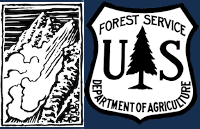We skied Wheeler via South Cottonwood and found that the two gullies on the East and South East aspects had recently run in their entirety. We could only see the crown on the South East gully but it appeared to have broke on the steepest part of the slope near the top approximate 3-4ft deep and was the width of the gully. Both avalanches ran the full length and width of their gullies, breaking several trees along the way. The East debris pile was about 25ft deep and the South East was 15ft deep.
Northern Gallatin
Debris pile from the slide in Taylor’s Fork, crown of about 5-6’ and about 100' wide. Human triggered. Photo: Matt Seifert
Natural avalanche east of the top of Lick Creek
From an observation, "This activity appears to have occurred naturally. No signs of a skin track or skiing. No accurate indication of when it happened, tho appeared fairly recent with no new wind loading."
From an observation, "This activity appears to have occurred naturally. No signs of a skin track or skiing. No accurate indication of when it happened, tho appeared fairly recent with no new wind loading." Photo: R. Siberrel
From an observation, "This activity appears to have occurred naturally. No signs of a skin track or skiing. No accurate indication of when it happened, tho appeared fairly recent with no new wind loading." Photo: R. Siberrel
Natural avalanche on Alex Lowe Peak
From an email:
"Near the ridge line of Mt. Blackmore we noticed the East facing slope close to the ridge line was clearly wind loaded and felt collapsing and cracking under our skis. None of those cracks shot out however. We dug a pit on an E- SE facing slope near the ridge line and found no signs of stability, however we ran into a group on our way up who said they dug a pit in a similar area and got an ECTP-22. Looking N-NW from the ridge line we saw some an avalanche crown on the adjacent face (Alex Lowe Peak)."
This is the second time this avalanche path released. See a photo from 1/25/20 HERE.
Picture taken on Alex Lowe Peak from Mount Blackmore. This is the second time this avalanche path released. See a photo from 1/25/20 HERE. Photo: Zane Heaton
Picture taken on Alex Lowe Peak from Mount Blackmore. This is the second time this avalanche path released. See a photo from 1/25/20 HERE. Photo: Zane Heaton
Large natural avalanche in Middle/Bear Basin
We encountered a natural avalanche that appears to have been triggered by a cornice drop. There seemed to be very little fresh snow on the slide surface so we suspect it occurred recently (Feb 14?). The slide occurred on the west side (east facing side) of Bear Basin (pinpoint on the map below). The avalanche was probably 200 feet wide at the top so it clearly propagate across the slope. Crown was 2 to 5 feet tall. We did not hike in there to investigate more carefully. There is a fair amount of trees on this part of the ridge. The picture shows how some large chunks got hung up on trees but we could see that the slide ran across the creek below (almost 1000 vertical feet). We had planned on skiing this slope and/or the open meadow (talus field) a hundred yards north but in light of this observation we turned around, skied back down in Middle Basin in the trees. Side note: we dug a pit earlier on an almost identical aspect (on the Beehive/Middle basin ridge) and obtained ECTN 16 @ 12" below the surface, ECTN 23 @4" below that, ECTN 28 @ 6" below that... Basically some definition between the latest storm layers but no propagation, and a right-side up snow pack. We only dug about 3 feet deep so this pit did not assess the ground level facets, which we figure are wide spread. The natural slide we encountered one ridge over seemed to be a case where a thin area was triggered by a cornice drop.
